Tired of feeling like you have to post on social media all the time to get coaching clients?
Good news — you don’t need Instagram, Facebook, X (formerly Twitter), or TikTok to build a successful coaching business.
Yep, this means no silly dances too.
Many coaches and course creators find that moving away from social media actually allows them to focus on more sustainable, long-term strategies that bring in better clients.
Let’s explore how to make this work, shall we?
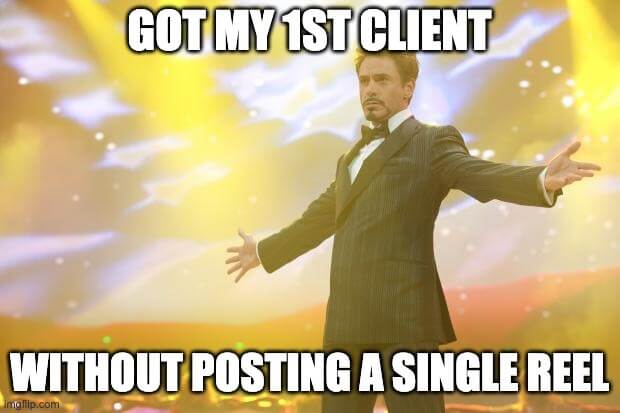
Building a Successful Coaching Business Foundation
The Basics
Before you get to marketing strategies, you need a foundation. Think of this as building a house — you wouldn’t start with the roof, would you?
Many coaches jump straight into marketing without this crucial groundwork and wonder why their efforts aren’t converting into paying clients.
Your Ideal Client Avatar

First, get super clear on who your ideal client is.
Are they busy professionals seeking work-life balance? Entrepreneurs looking to scale their business?
The more specific you are, the easier it is to find and attract them. Create a detailed avatar including:
Demographics (age, income, location, education)
Psychographics (values, beliefs, lifestyle)
Pain points and challenges
Goals and aspirations
Where they currently seek solutions
What they’ve tried before
Their objections to coaching
For example, instead of saying “I help entrepreneurs,” specify “I help female e-commerce business owners earning $100K-$500K who want to scale to seven figures while working fewer hours.”
How to Get Coaching Clients Without Social Media – Way #1: SEO
Search Engine Optimization (SEO) is your secret weapon.
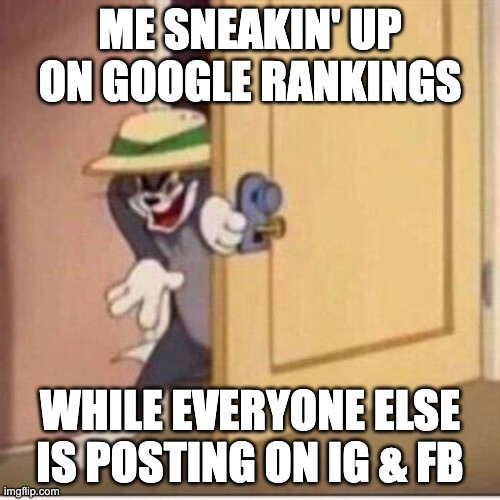
While social media requires constant feeding, SEO is like planting a garden that keeps growing.
Focus on keywords your ideal clients are searching for. If you help entrepreneurs with time management, create content around:
“Productivity tips for business owners”
“How to delegate effectively”
“Time management for entrepreneurs”
“Business systems and automation”
“Work-life balance for CEOs”
Technical SEO Basics
Optimize page titles and meta descriptions
Use header tags
Include keywords naturally
Create internal links between pages
Ensure fast loading speeds
Make your site mobile-friendly
Create location-specific pages if relevant
Local SEO
Don’t forget to claim and optimize your Google My Business listing.
This is especially important for coaches who work locally or offer hybrid coaching services. Include:
Business hours
Regular posts and updates
Photos of your workspace or virtual office
Client reviews
Services
FAQs
Content Marketing Strategies
Content marketing is about sharing your expertise in valuable ways.
Your blog is the foundation of this strategy. Create a content calendar around:
Challenges your ideal clients face
Questions they ask
Industry trends and insights
Success stories and case studies
How-to guides and tutorials
Expert interviews
Resource roundups
Expanding your content marketing beyond blogging can make a big difference in getting coaching clients without social media.
Create video content to reach those who prefer visual learning. Host webinars or online workshops to dive deeper into specific topics and give potential clients a taste of your coaching style.
And create a podcast series to reach another segment of your audience and share your insights and advice in a more casual way.
Collaborate with other coaches or industry experts to expand your reach and offer different perspectives.
Don’t forget to repurpose your blog posts into infographics, slideshows or downloadable guides.
This not only uses your content more efficiently but also caters to different learning styles.
By diversifying your content formats you can drive more traffic to your site and become a thought leader in your niche and get more clients without social media.
Blog Post Best Practices
When writing blog posts:
Use attention grabbing headlines
Include practical tips
Break up text with subheadings
Add images
Include examples and case studies
End with clear next steps
Optimize for SEO
Insert internal and external links
Guest Blogging / Posting
Guest posting on other websites puts you in front of established audiences.
Look for websites your ideal clients already read.
For example if you’re a business coach look for entrepreneurship websites.
When guest posting:
Study the site’s content style
Pitch unique angles
Deliver big value
Include your bio and call-to-action
Comment on the post
Share the post with your network
Podcasting
Podcasting is great for coaches. Being a guest on podcasts gets you in front of existing audiences.
Consider starting your own podcast if you like talking and have valuable insights to share regularly.
Focus on:
Consistent publishing schedule
Good audio
Interesting topics
Expert guests
Practical content that’s easy to implement
Clear call-to-action
Way #2: Email Marketing and List Building
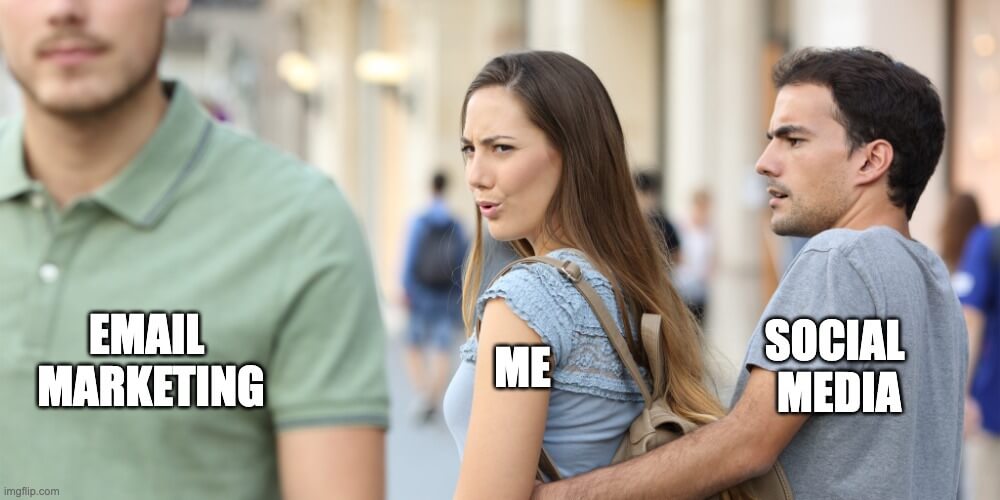
Building an Email List Using Lead Magnets
Create lead magnets that solve immediate problems.
These should be specific, practical and deliver quick wins.
Here are some examples:
Productivity assessment tool
Goal setting workbook
“Mistakes” challenge where you uncover the most common mistakes people make
Business systems checklist
Templates for writing engaging emails while invisibly selling
ROI calculators
Self-assessment quizzes
Lead magnets are a great way to get coaching clients without social media. By offering valuable resources you’re giving potential clients a taste of your expertise and building trust and credibility.
Consider creating lead magnets for specific niches or pain points within your coaching business.
For example, if you’re a health coach you might create a meal planning guide or a fitness tracker. As a business coach a financial planning spreadsheet or a business strategy session might be more relevant
And make sure your lead magnets look good and are easy to get.
Use landing pages to capture email addresses in exchange for these resources and grow your list and nurture potential clients through targeted email campaigns.
By delivering value through your lead magnets you can build a relationship with your audience and convert them into clients over time.
Email is your direct line to clients. Start building your list now with your lead magnets.
Your email strategy should be total and systematic.
Welcome Sequence
Your welcome sequence should look like this:
Day 1: Welcome email with your introduction and lead magnet
Day 3: Share your coaching story and philosophy and a client success story
Day 5: Deliver value with tips or insights related to the resource they downloaded
Day 7: Share common problems and solutions in your niche
Day 9: Invite them to book a consultation with an offer
Newsletters
Newsletters keep you top of mind. Mix in:
60% educational content
20% stories
20% promotional content
Newsletter best practices:
Use great subject lines
Keep paragraphs short
One main call-to-action
Personal touches
Behind the scenes
Segmentation based on interests
Test different send times
Monitor open and click rates
To implement email marketing, you need a tool like BirdSend.
Way #3: Partnership and Networking
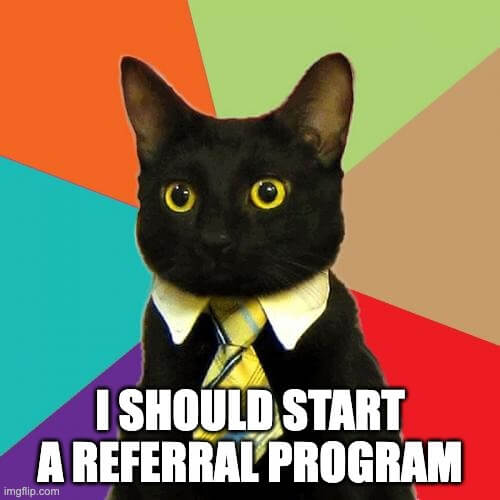
Your network is your net worth in coaching. Start with people you already know. Create a networking strategy that includes:
Immediate Network Activation:
Let your existing contacts know about your coaching services. Show how you’re different from other coaches and how you can help their connections.
1:1 calls with potential partners who have your target audience. Get to know their audience so you can help them.
Give special discounts to early adopters to try out your coaching services. In return you get constructive feedback to improve your offerings. You might even get some testimonials.
Ask for intros to potential partners from your immediate circle. A warm intro helps in building trust and credibility.
Share your expertise in relevant communities by helping out other members. You can also contact the community or group owner and ask if they’re open to you giving a free webinar session to the community members.
Create a Referral / Affiliate Program
If you don’t know what an affiliate program is, see here.
Offer current clients or anyone who might have access to your audience:
10-20% commissions based on how much the coaching service or package is
A free coaching session for clients who refer you to their network
Make it easy for people to refer you. Provide them with intro templates and resources
Make sure to use a reliable tracking software to accurately track referrals and how much commissions need to be paid. Then pay out the commissions on time. Transparency and punctuality is key to strong referral relationships.
Thank referral partners regularly. For those who keep referring you clients, you can also give them a special gift (e.g. Amazon vouchers) on top of their commissions.
Local Networking
Attend Chamber of Commerce events to meet and interact with local business owners and professionals. Folks going to these events are business-minded and don’t mind being pitched (if you do it correctly).
Also attend industry conferences to stay up to date with things happening in your field. Network with other professionals while you’re there. You never know who is going to refer you clients.
Host local workshops to show off your expertise. Make sure you attract the right type of audience, otherwise it’ll be a waste.
Speak at business breakfast or luncheons to reach a bigger audience. Tell your origin story, then transition into how you can help them.
Partner with complementary but non-competing businesses. For example, if you’re a fitness coach, you can partner with businesses that sell fitness equipments to cross promote services.
Join mastermind groups in your field to connect with like-minded professionals to share knowledge and support one another. You might even get collaboration opportunities
How to Get Coaching Clients Without Social Media – Way #4 Paid Marketing
Yes, organic traffic is free, but you’re paying it with your time. So if you have more money than time, consider paid advertising.
Google Ads
Start with a small daily budget ($20 – $50)
Target long-tail keywords
Write intriguing and enticing ad copy (while avoiding click-baiting)
Use ad extensions for easier management
Set up conversion tracking
A/B test to find the winning ad creative
Monitor and adjust
Meta Ads
Create custom audiences from your website visitors
Create lookalike audiences from your email list
Test different ad formats and creatives
Set up tracking pixels
Monitor cost per lead and adjust
Webinar Marketing
Show the audience how you can help solve their pains and problems
Plan the webinar at least a month in advance
Send multiple reminder emails (2 days prior, 1 day prior, and 1 hour prior, and 10 minutes prior)
Include interactive elements by asking the audience questions
Make a relevant and compelling offer (make sure if they don’t buy, they’ll still get value out of the webinar)
Send the webinar replay so those who didn’t attend can watch (and potentially buy your offer)
Follow up via emails (the saying “the money is in the follow-up is true”
Way #5 Community Building
With social media, it’s a “shotgun approach” in terms of audience targeting. You don’t really have a say in who you want your posts to reach.
With a community though, only those who’re interested in your topic will join.
Here are few ways to build goodwill and trust with your community:
1/ Workshops / trainings
Once a month, host online trainings that cover recent trends or industry news. This is useful for members because they can keep up to date just by attending or watching the training.
2/ Guest expert trainings
You can also invite relevant experts to give trainings.
For example, if your community building is about running a successful agency business, members most likely have problems with productivity, mindset, cashflow management, etc.
3/ Implementation workshops
This is where members can apply what they’ve learned live with other members / students.
This is a good, practical way for them to actually “acquire” skills, not just learn about them theoretically.
4/ Hot seats

This is where a select few members get focused 1:1 coaching from you in front of the group.
Because of the nature of the personalized interactions, each session can usually only accommodate not more than 3-5 hot seats.
Members who haven’t got their chance to be “hot-seated” can wait until the next hot seat session.
5/ Challenges
Create relevant and measurable goals for your members. You can also encourage them to come up with ideas. These goals will keep members engaged and focused, and ultimately achieve something positive. This will further build goodwill.
6/ Daily action steps
This is to get participants moving towards their goals. Breaking down goals into smaller tasks will get results and engagement.
7/ Accountability
This is done through regular check-ins, progress tracking and peer support. Accountability is what keeps participants motivated.
8/ Celebrate wins (and “failures”)
Recognize achievements and milestones.
Celebrating success will keep morale high and get more participation.
But the reality is — there are much more setbacks / “failures” than wins.
Encourage members to celebrate failures and share them too as doing so will make your community more “realistic” and humane.
9/ Recognize helpful members
Showcase their contributions and achievements like giving them a special badge.
Humans like to be recognized — so use this to your advantage. Once someone is awarded a badge, they don’t want to lose it.
This means they’re more likely to continue with their helpful contribution within the community.
10/ Set rules and guidelines
This is to keep your community positive and supportive.
For example, most communities (especially paid ones) don’t allow self-promotion. Make this clear right from the very beginning to set clear expectations.
Measuring Your Results
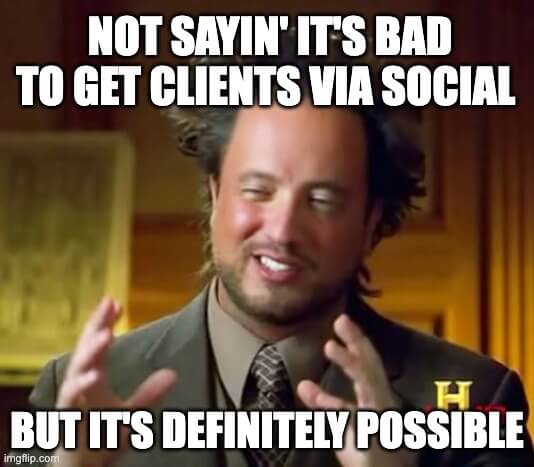
Track these each month:
Website traffic (20% growth)
Email list growth (100 new subscribers)
Consultation call bookings (weekly goals)
Client conversion rates (25-30%)
Revenue per client (track averages and trends)
Client satisfaction scores (9+/10)
Referral rates (20% of new clients)
Use these:
Email marketing analytics
CRM system
Financial tracking software
Client feedback surveys
ROI calculators
Performance dashboards
Remember, you can attract coaching clients without social media. Focus on being helpful to your audience and you’ll build strong and trusting relationships.
Your ideal clients are out there looking for help to overcome their problems. And you have the expertise to solve them.
By being visible in the right places and delivering high quality service you’ll build a thriving coaching business without the social media overwhelm.
Oh and before I forget, thank you Imgflip for the fun images.
Related Reading
Where to buy digital products to resell
- SendOwl vs Gumroad: The Recurring Revenue Black Hole (2026)
- Gumroad vs Sellfy: The Vendor Lock-in Cage (2025)
- Gumroad vs Payhip: The Hidden Trap for Creators (2025)
- ThriveCart vs SamCart – The Subscription Hostage Trap (2025)
- 8 ThriveCart Alternatives & The Lifetime Pricing Paradox (2025)
- 8 SamCart alternatives + Subscription hostage (2025)
- The GENTLE Method: Soft marketing for creators
- How Far in Advance Should You Promote a Webinar?
- The SAVINGS Method: The Productivity Improvement Plan for Creators
- 9 Questions to Ask: How to Hire a Digital Marketing Agency
